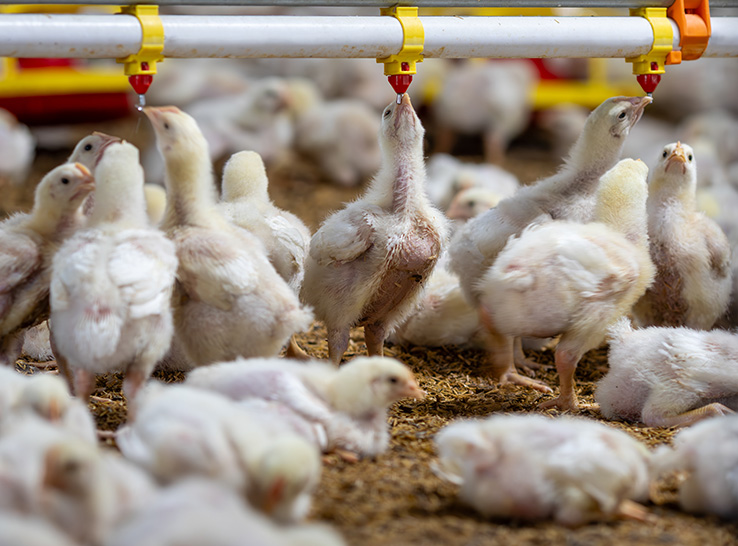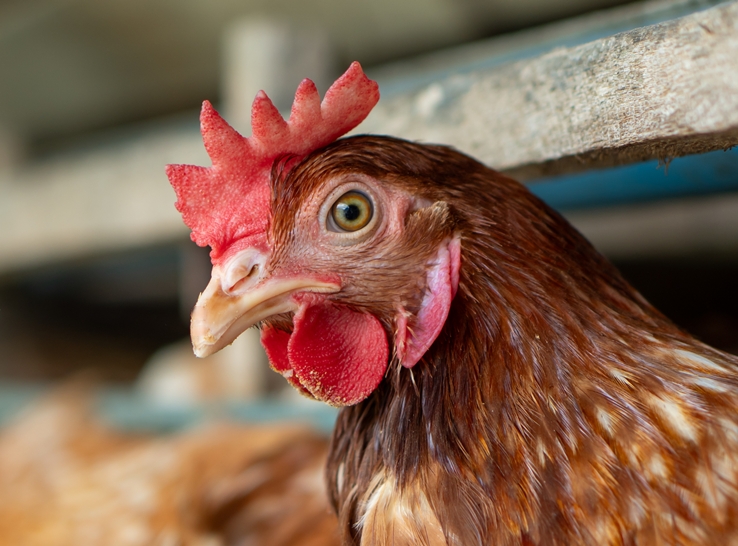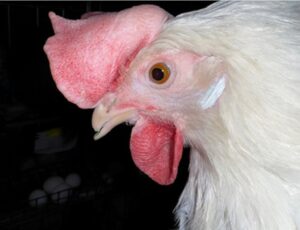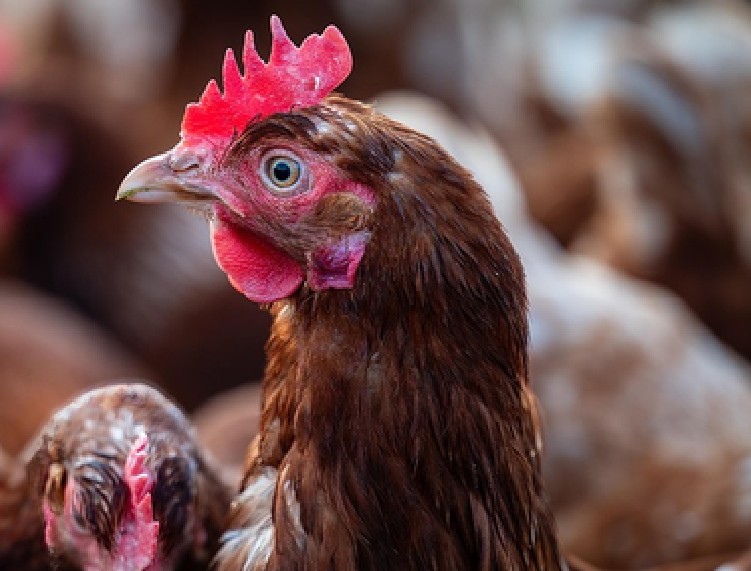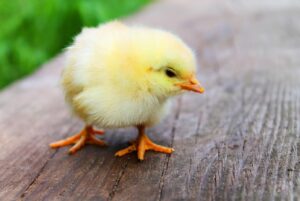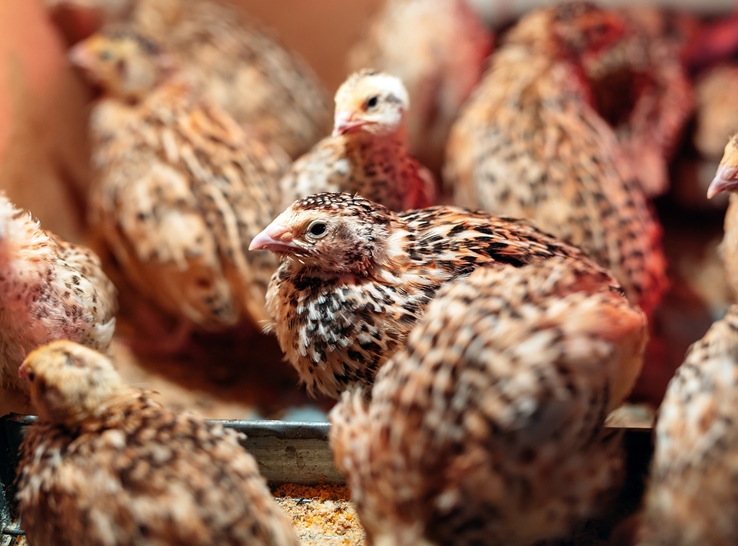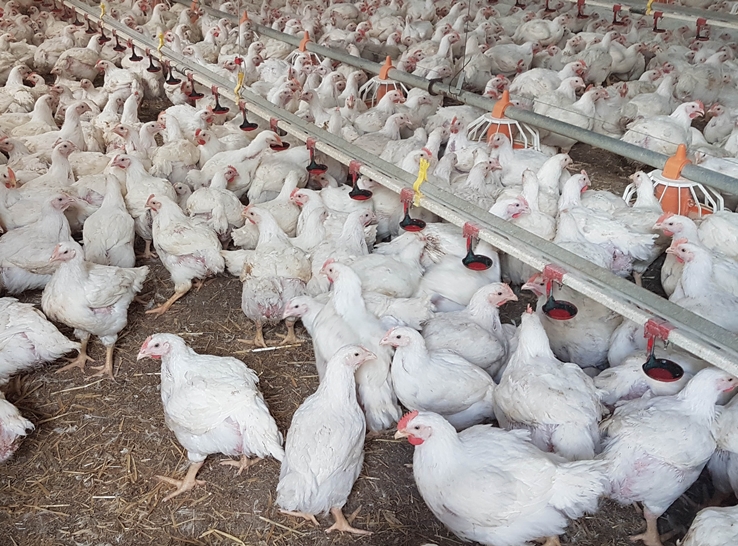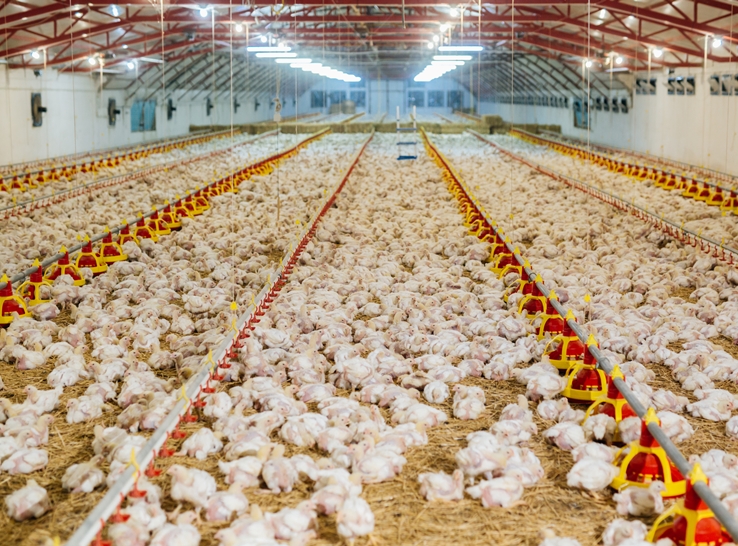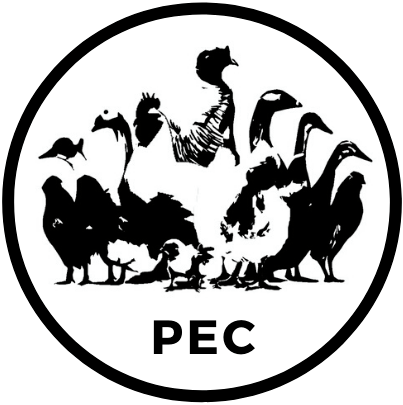By Harliqueen Jacinto and Marisa Erasmus, PhD, Purdue University
The beak serves as an important body part of hens, which enables them to perform essential tasks like feeding, maintaining their feathers, removing parasites, exploring their habitat, building nests, and engaging in social interactions with other hens (Janczak & Riber, 2015). However, it also plays a role in social interactions within the flock.
Beak trimming or beak conditioning is a common practice in the management of laying hens. It involves the removal of a portion of a bird’s beak to minimize harmful behaviors such as feather pecking and cannibalism (Jendral & Robinson, 2004), which are major welfare concerns in the poultry industry. Injurious pecking, such as severe feather pecking, can increase distress within the flock. While beak trimming helps reduce injuries among birds and improves productivity, the technique has also raised animal welfare concerns (Riber & Hinrichsen, 2017). Thus, farmers and researchers are continuing to explore ways to manage hens without the need to trim their beaks.
Why beak trimming is done
Beak trimming is performed to remove the sharp tip of the beak, which can cause injury during pecking. While the pecking behavior itself may continue, removing the tip reduces the severity or occurrence of injuries to conspecifics.

Figure 3. Back of chicken that has experienced feather pecking.
Image from: https://extension.umd.edu/resource/feather- pecking-and-cannibalism/
This practice is considered effective at reducing mortality and maintaining good plumage condition, which are important parameters in poultry production (Milisits et al., 2021).
Injurious pecking, which involves hens pecking at each other’s feathers, vents, or skin, can be prevalent, leading to increase distress among hens in socially housed poultry (El-Lethey et al., 2000). It is difficult to manage due to the many factors that affect its development and occurrence. To learn more about it, see our previous article on injurious pecking.
Types of pecking
Gentle Feather Pecking (GFP): Involves light pecks to the tips of feathers which typically causes no damage or removal of the feathers (Harlander-Matauschek et al., 2009). It generally causes no physical harm and is often tolerated by the recipient, however, when repeated excessively, it may indicate underlying welfare concerns in the pecking bird (Rodenburg et al., 2013; Savory, 1995).
Severe Feather Pecking (SFP): This involves strong, targeted pecks that often result in feather removal and can lead to visible feather loss (Rodenburg et al., 2013; Savory, 1995).
Vent Pecking and Cannibalism. This is a specific and highly aggressive form of pecking directed at the vent area of another bird. It can involve pulling out internal tissues and may occur even in birds with intact plumage, often emerging around the onset of egg laying (Rodenburg et al., 2013; Savory, 1995). In severe cases, this behavior can escalate to cannibalism, where birds not only damage the skin and underlying tissues but may also consume exposed body parts, which is most likely to happen when tissue becomes accessible after injury (Savory, 1995).
Methods of beak trimming
Beak trimming is typically performed on young chicks, either at the hatchery on the day of hatch or in the pullet house before 10 days of age, depending on the method used. It may be done at an older age, but the implications and effectiveness of late-age beak trimming on welfare and production merit careful consideration. There are two main methods:
- Hot Blade Trimming (HB): This is a traditional method which involves using a heated blade to remove the tip of the beak, simultaneously cauterizing the wound to prevent bleeding. It is commonly performed at the pullet farm within the first 10 days of age. This method may cause immediate discomfort and, in some cases, lead to long-term sensitivity depending on the bird’s age and the extent of the trim. Hot-blade trimming is also frequently associated with a higher incidence of beak abnormalities compared to infrared beak trimming, including cracks and asymmetric regrowth (Kaba & Bozkurt, 2023). Furthermore, it can impair normal beak function, potentially reducing feeding and preening efficiency (Kuenzel, 2007; Mullens et al., 2010). An example image of hot blade trimming can be viewed here.
- Infrared Beak Treatment (IRBT): This method is considered a more welfare-friendly approach to beak trimming, as it causes less pain and has fewer negative effects on hen behavior compared to traditional hot blade trimming (Dennis et al., 2009; Petrolli et al., 2017). It is performed in the hatchery on one-day-old chicks. Infrared light is used to cauterize the tip of the beak, which then falls off after a few days. Birds trimmed using IRBT have shown better feeding efficiency, body development, and production outcomes compared to those trimmed with the hot blade method (Guarnieri et al., 2020; Dennis and Cheng, 2010). To learn more about IRBT, click here.
Welfare concerns
While beak trimming helps prevent serious injuries, it raises several welfare concerns spanning from the early days as chicks to maturity as laying hens.
1. Pain
A chicken’s beak is very sensitive because it has many nerves and trimming it can cause pain. Traditional methods, like hot blade trimming, may lead to significant tissue damage and inflammation, resulting in both acute and chronic pain (Glatz & Underwood, 2020), especially if done in birds at older ages (Gentle, 2011). Newer techniques, such as infrared beak trimming methods, have shown promise in reducing pain and tissue damage compared to traditional method (Dennis et al., 2009), but there are still concerns such as pain and sensory loss resulting from any form of beak trimming to the welfare of individual birds.
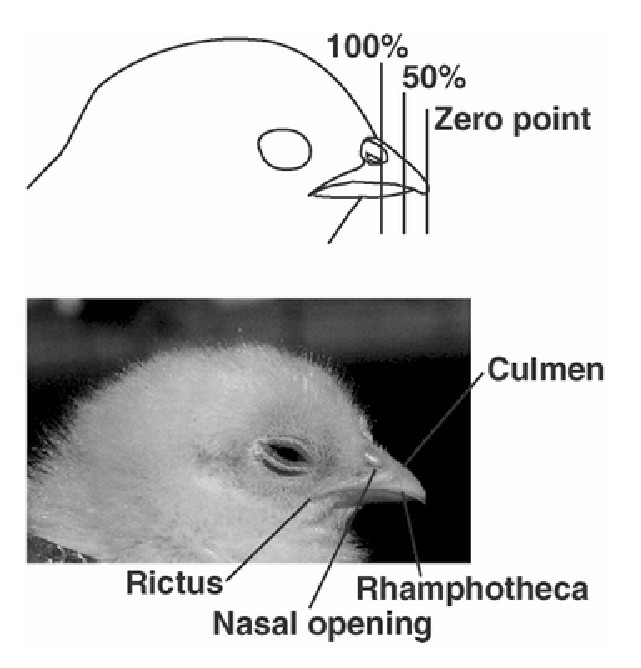
Figure 5. External anatomy of the beak and related structures, illustrating how the length of the trimmed portion is determined.
Image from Kuenzel, W.J. (2007).
Neurobiological Basis of Sensory Perception: Welfare Implications of Beak Trimming. Poultry Science, ©2007 Elsevier. Used under Creative Commons CC BY-NC-ND license.
2. Changes in behavior
Chickens generally spend a large portion of their time budget pecking and exploring, but after trimming, they may become less active (Glatz & Underwood, 2020) and instead spend more time resting. This may occur immediately after trimming when they are chicks, and in some cases, it may persist over time.
3. Difficulty in eating and foraging
The function of the beaks is to pick up food and exploration of the surroundings. After beak trimming, there is a possibility for a reduction in feeding or foraging activities, leading to:
- Reduction in food intake, which can affect growth performance and egg production.
- Frustration because they are unable to peck as they normally would.
Over time, acclimation to beak trimming may occur, but their ability to peck and forage will not be as effective as it likely would have been if they had not undergone beak trimming.
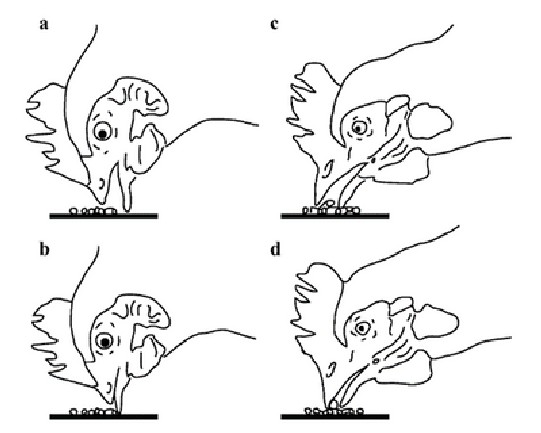
Figure 6. Illustrations of gaping and beak closure events in beak-trimmed bird (a and b) compared to bird with intact beak (c and d).
Image from Prescott, N.B., & Bonser, R.H.C. (2004). Beak Trimming Reduces Feeding Efficiency of Hens, Journal of Applied Poultry Research, ©2004 Elsevier. Used under Creative Commons CC BY-NC-ND license.
4. Social interactions, hygiene, and health
Pecking and preening (cleaning their feathers) are important social behaviors for hens. Preening can be both individual and social as hens often engage in allopreening, where they clean and groom each other’s feathers, which strengthens social bonds within the flock. Beak trimming can make these activities harder, which may affect how hens interact with each other and how well they keep their feathers clean. This may also negatively affect their health, as an intact beak plays an important role in preventing issues such as ectoparasite infestations (Vezzoli et al., 2015).
Alternatives to beak trimming
Table 1. Some alternatives to beak trimming.
|
Alternatives |
|
| Breeding calmer hens | Genetic selection of calmer hens with reduced tendencies for injurious feather pecking presents a promising alternative to beak trimming (Cheng, 2006; Rodenburg & Turner, 2012). Breeding programs have been initiated to reduce the prevalence of severe feather pecking and cannibalism in some genetic lines of laying hens (Kjaer et al., 2001; Nordquist et al., 2011; Rodenburg et al., 2010). |
| Environmental enrichment (EE) | Provision of EE can reduce injurious pecking in the flock (van Staaveren et al., 2021). Providing hens with access to enrichments such as pecking blocks, straw bales, dust baths, and foraging materials reduces boredom- driven pecking and limits the risk of severe feather pecking outbreaks. A stimulating environment prevents redirection of natural pecking behaviors towards other hens. |
| Management strategies | Alternative management strategies including adjusting indoor environments such as lighting (Kaukonen & Valros, 2019) or low stocking densities may lead to a reduction in both feather pecking and cannibalism (Schwarzer et al., 2021). |
| Improving diet quality | Feeding regimens that provide required levels of key amino acids and maximize dietary fiber content can significantly reduce the incidence of injurious pecking behaviors in hens, as higher fiber levels seem to provide better satiety and promote normal foraging behaviors (Kalmendal & Bessei, 2012; Mens et al., 2020). |
| Provision of good foraging opportunities | Offering adequate foraging opportunities could significantly decrease feather pecking incidents (Gilani et al., 2013). This could be done by providing suitable foraging materials and by allowing hens to have access to outdoor areas or indoor foraging zones where they can engage in natural pecking behaviors. Hens that can forage naturally are less likely to exhibit injurious behaviors stemming from boredom or frustration, as they are actively engaging in behaviors that fulfill their instincts. |
In addition to using alternatives to beak trimming, it is recommended to regularly check the flock for signs of feather damage so that feather pecking can be identified early, and strategies implemented to prevent feather pecking from progressing into cannibalism (Kittelsen et al., 2022).
Changes in regulations
In many countries, regulations exist to limit or ban beak trimming. For example, some European countries like Denmark, Sweden, and Norway have completely banned the practice (Jung & Knierim, 2018). Other countries encourage farmers to adopt alternative methods, such as improved management practices and environmental enrichment, to reduce the need for beak trimming. In other countries, such as the United States, beak trimming is practiced as a method to reduce and prevent injurious pecking and is not prohibited by federal law, although certification programs and animal welfare organizations such as the Certified Humane® certification program (https://certifiedhumane.org/beak-trimming/) and the American Humane Certified™ program (Animal Welfare Standards, 2021) permit beak trimming only under strict guidelines.
Conclusion
- Beak trimming is commonly used to prevent injuries caused by behaviors like feather pecking.
- While effective, it can result in pain and behavioral changes in hens.
- With increasing animal welfare concerns, there is a need to explore and implement alternatives to beak trimming.
- Alternative strategies for reducing injurious pecking include:
- Breeding for birds with lower tendencies to peck injuriously
- Improving environmental conditions and overall management practices
- Ensuring adequate and balanced nutrition
- Promoting natural behaviors such as foraging and preening
References
- American Humane. (2021). Animal Welfare Standards for Laying Hens- Free Range & Pasture. Retrieved March 4, 2025, from https://www.americanhumane.org/app/uploads/2022/06/Layers-Free-Range-and-Pasture-Full-Standards- 2c-2021.09.10-FINAL.pdf
- Certified Humane. Beak trimming. Retrieved March 4, 2025, from https://certifiedhumane.org/beak-trimming/
- Cheng, H. (2006). Morphopathological changes and pain in beak trimmed laying hens. World’s Poultry Science Journal, 62(1), 41–52. https://doi.org/10.1079/WPS200583
- Dennis, R. L., Fahey, G., & Cheng, H. W. (2009). Infrared beak treatment method compared with conventional hot- blade trimming in laying hens. Poultry Science, 88(1), 38–43. https://doi.org/10.3382/ps.2008-00227
- El-Lethey, H., Aerni, V., Jungi, T. W., & Wechsler, B. (2000). Stress and feather pecking in laying hens in relation to housing conditions. British Poultry Science, 41, 22–28. https://doi.org/10.1080/00071660086358
- Gentle, M. J. (2011). Pain issues in poultry. Applied Animal Behaviour Science, 135(3), 252–258. https://doi.org/10.1016/j.applanim.2011.10.023
- Gilani, -M., Knowles, T. G., & Nicol, C. J. (2013). The effect of rearing environment on feather pecking in young and adult laying hens. Applied Animal Behaviour Science, 148(1), 54–63. https://doi.org/10.1016/j.applanim.2013.07.014
- Glatz, P. C., & Underwood, G. (2020). Current methods and techniques of beak trimming laying hens, welfare issues and alternative approaches. Animal Production Science, 61(10), 968–989. https://doi.org/10.1071/AN19673
- Guarnieri, P. C., Pagnussatt, H., Aniecevski, E., Santo, D., Leite, F., Valentini, F. D. A., Facchi, C. S., Zaccaron, G., Bosetti, G. E., Rossatto, G., Boiago, M. M., Tavernari, F. C., Artoni, S. M. B., & Petrolli, T. G. (2020). Comparison between infrared and hot-blade beak trimming methods in white and brown pullets: Performance, organ and bone development. Arquivo Brasileiro de Medicina Veterinária e Zootecnia, 72, 2373–2380. https://doi.org/10.1590/1678- 4162-11964
- Harlander-Matauschek, A., Beck, P., & Piepho, H.-P. (2009). Taste aversion learning to eliminate feather pecking in laying hens, Gallus gallus domesticus. Animal Behaviour, 78(2), 485–490. https://doi.org/10.1016/j.anbehav.2009.05.020
- Janczak, A. M., & Riber, A. B. (2015). Review of rearing-related factors affecting the welfare of laying hens. Poultry Science, 94(7), 1454–1469. https://doi.org/10.3382/ps/pev123
- Jendral, M., & Robinson, F. E. (2004). Beak trimming in chickens: Historical, economical, physiological and welfare implications, and alternatives for preventing feather pecking and cannibalistic activity. Avian and Poultry Biology Reviews, 15, 9–23. https://doi.org/10.3184/147020604783637444
- Jung, L., & Knierim, U. (2018). Are practice recommendations for the prevention of feather pecking in laying hens in non-cage systems in line with the results of experimental and epidemiological studies? Applied Animal Behaviour Science, 200, 1–12. https://doi.org/10.1016/j.applanim.2017.10.005
- Kaba, S., & Bozkurt, Z. (2023). The impact of strain and cage type on the welfare of laying hens in different seasons. Journal of Poultry Research, 20(2), Article 2. https://doi.org/10.34233/jpr.1408718
- Kalmendal, R., & Bessei, W. (2012). The preference for high-fiber feed in laying hens divergently selected on feather pecking. Poultry Science, 91(8), 1785–1789. https://doi.org/10.3382/ps.2011-02033
- Kaukonen, E., & Valros, A. (2019). Feather Pecking and Cannibalism in Non-Beak-Trimmed Laying Hen Flocks— Farmers’ Perspectives. Animals, 9(2), 43. https://doi.org/10.3390/ani9020043
- Kittelsen, E., Tahamtani, F., Moe, R. O., Gretarsson, P., & Vasdal, G. (2022). Flock Factors Correlated with Elevated Mortality in Non-Beak Trimmed Aviary-Housed Layers. Animals, 12(24), Article 24. https://doi.org/10.3390/ani12243577
- Kjaer, J. B., Sørensen, P., & Su, G. (2001). Divergent selection on feather pecking behaviour in laying hens (Gallus gallus domesticus). Applied Animal Behaviour Science, 71(3), 229–239. https://doi.org/10.1016/S0168-1591(00)00184- 2
- Kuenzel, W. J. (2007). Neurobiological Basis of Sensory Perception: Welfare Implications of Beak Trimming. Poultry Science, 86(6), 1273–1282. https://doi.org/10.1093/ps/86.6.1273
- Mens, A. J. W., van Krimpen, M. M., & Kwakkel, R. P. (2020). Nutritional approaches to reduce or prevent feather pecking in laying hens: Any potential to intervene during rearing? World’s Poultry Science Journal, 76(3), 591–610. https://doi.org/10.1080/00439339.2020.1772024
- Milisits, , Szász, S., Donkó, T., Budai, Z., Almási, A., Pőcze, O., Ujvári, J., Farkas, T. P., Garamvölgyi, E., Horn, P., & Sütő, Z. (2021). Comparison of Changes in the Plumage and Body Condition, Egg Production, and Mortality of Different Non-Beak-Trimmed Pure Line Laying Hens during the Egg-Laying Period. Animals, 11(2), 500. https://doi.org/10.3390/ani11020500
- Mullens, B. , Chen, B. L., & Owen, J. P. (2010). Beak condition and cage density determine abundance and spatial distribution of northern fowl mites, Ornithonyssus sylviarum, and chicken body lice, Menacanthus stramineus, on caged laying hens1. Poultry Science, 89(12), 2565–2572. https://doi.org/10.3382/ps.2010-00955
- Nordquist, R. E., Heerkens, J. L. T., Rodenburg, T. B., Boks, S., Ellen, E. D., & van der Staay, F. J. (2011). Laying hens selected for low mortality: Behaviour in tests of fearfulness, anxiety and cognition. Applied Animal Behaviour Science, 131(3), 110–122. https://doi.org/10.1016/j.applanim.2011.02.008
- Petrolli, G., Petrolli, O. J., Girardini, L. K., Zotti, M., Baggio, R. A., & Junqueira, O. M. (2017). Effects of Laser Beak Trimming on the Development of Brown Layer Pullets. Brazilian Journal of Poultry Science, 19, 123–128. https://doi.org/10.1590/1806-9061-2016-0307
- Prescott, N. B., & Bonser, R. (2004). Beak Trimming Reduces Feeding Efficiency of Hens. J. Appl. Poult. Res, 13, 468–471. https://doi.org/10.1093/japr/13.3.468
- Riber, B., & Hinrichsen, L. K. (2017). Welfare Consequences of Omitting Beak Trimming in Barn Layers. Frontiers in Veterinary Science, 4, 222. https://doi.org/10.3389/fvets.2017.00222
- Rodenburg, T. B., Bijma, P., Ellen, E. D., Bergsma, R., Vries, S. de, Bolhuis, J. E., Kemp, B., & Arendonk, J. van. (2010). Breeding amiable animals? Improving farm animal welfare by including social effects in breeding programmes. Animal Welfare, 19(S1), 77–82. https://doi.org/10.1017/S0962728600002268
- Rodenburg, T. B., Krimpen, M. M. V., Jong, I. C. D., Haas, E. N. D., Kops, M. S., Riedstra, B. J., Nordquist, R. E., Wagenaar, J. P., Bestman, M., & Nicol, C. J. (2013). The prevention and control of feather pecking in laying hens: Identifying the underlying principles. World’s Poultry Science Journal, 69(2), 361–374. https://doi.org/10.1017/S0043933913000354
- Rodenburg, T. B., & Turner, S. P. (2012). The role of breeding and genetics in the welfare of farm animals. Animal Frontiers, 2(3), 16–21. https://doi.org/10.2527/af.2012-0044
- Savory, C. J. (1995). Feather pecking and cannibalism. World’s Poultry Science Journal, 51(2), 215–219. https://doi.org/10.1079/WPS19950016
- Schwarzer, A., Erhard, M., Schmidt, P., Zismann, M., & Louton, H. (2022). Effects of Stocking Rate and Environmental Enrichment on the Ontogeny of Pecking Behavior of Laying Hen Pullets Confined in Aviary Compartments during the First 4 Weeks of Life. Animals : An Open Access Journal from MDPI, 12(19), 2639. https://doi.org/10.3390/ani12192639
- Schwarzer, , Plattner, C., Bergmann, S., Rauch, E., Erhard, M., Reese, S., & Louton, H. (2021). Feather Pecking in Non-Beak-Trimmed and Beak-Trimmed Laying Hens on Commercial Farms with Aviaries. Animals, 11(11), 3085. https://doi.org/10.3390/ani11113085
- van Staaveren, N., Ellis, J., Baes, C. F., & Harlander-Matauschek, A. (2021). A meta-analysis on the effect of environmental enrichment on feather pecking and feather damage in laying hens. Poultry Science, 100(2), 397–411. https://doi.org/10.1016/j.psj.2020.11.006
To view all issues of Poultry Press, click here.
Editor’s note: Content on Modern Poultry’s Industry Insights pages is provided and/or commissioned by our sponsors, who assume full responsibility for its accuracy and compliance.

